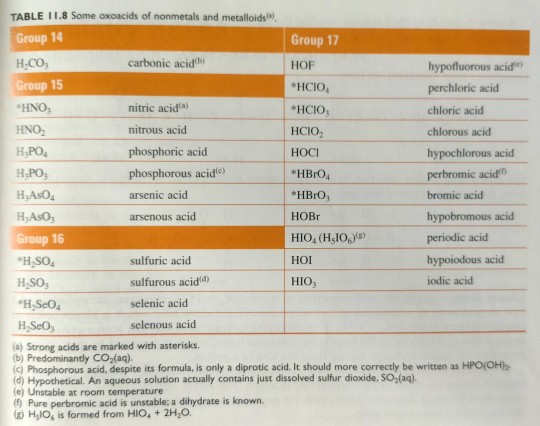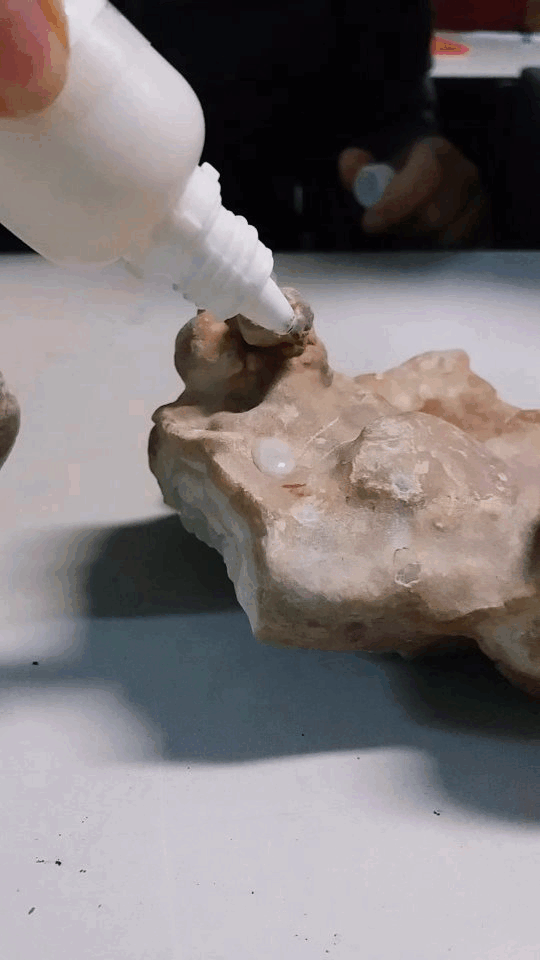#carbonic acid
Text
Acids composed of hydrogen, oxygen and some other element are called I do oxoacids (see table 11.8).

"Chemistry" 2e - Blackman, A., Bottle, S., Schmid, S., Mocerino, M., Wille, U.
#book quotes#chemistry#nonfiction#textbook#oxoacid#acid#hydrogen#oxygen#carbonic acid#nitric acid#nitrous acid#phosphoric acid#phosphorus acid#arsenous acid#sulfuric acid#sulfurous acid#selenic acid#selenous acid#hypofluorous acid#perchloric acid#chloric acid#chlorous acid#hypochlorous acid#perbromic acid#bromic acid#hypobromous acid#periodic acid#hypoiodous acid#iodic acid
0 notes
Text
Hey Plant People,
I have a question. I went to go water one of my plants, but i dont really trust the water out of my tap and I’m all out of bottled water—all I have at hand is seltzer water, which made me sad for my plants.
But then a thought occurred to me: Seltzer water is carbonated, and plants “breathe” CO2 right? So is Seltzer good for them? My biggest worry is that when carbon dioxide is dissolved in water it makes carbonic acid, which doesnt sound good—is it okay for them?
PS: while i have you here, how often should i water my wards? i have a cool little succulent one, a tiny cactus that looks like a pompom at the end of the weird winter beanies, and a taller but thinner cactus
#plants#plant moms#seltzer#carbonic acid#water#cactus#succulents#im bad at caring for myself let alone my wards
1 note
·
View note
Text
DIRK: Under communism, the wait staff will not ask if Pepsi is okay. You will not even find out that it's Pepsi instead of Coke until you take your first sip. Unless you train like me, to know the difference from the sound of the Fizz alone, that is the only way we can beat communism and I can teach you. Take my hand. Not like that you grabbed it gay. Stop. Giggles. I SAID STOP
#source: @coughloop#this goes directly against my longstanding headcanon that dirk has only drunk flat pop for so long that the carbonation is like acid to him#but like. the fucking fizz training? hed do it#homestuck#incorrect homestuck quotes#quote#mod dave#dirk strider
155 notes
·
View notes
Text
The carbonate compensation depth — a zone where high pressure and low temperature creates conditions so acidic it dissolves shell and skeleton — could make up half of the global ocean by the end of the century.
In the deepest parts of the ocean, below 13,100 feet (4,000 metres), the combination of high pressure and low temperature creates conditions that dissolve calcium carbonate, the material marine animals use to make their shells.
This zone is known as the carbonate compensation depth — and it is expanding.
This contrasts with the widely discussed ocean acidification of surface waters due to the ocean absorbing carbon dioxide from the burning of fossil fuels.
But the two are linked: because of rising concentrations of carbon dioxide in the ocean, its pH is decreasing (becoming more acidic), and the deep-sea area in which calcium carbonate dissolves is growing, from the seafloor up.
The transition zone within which calcium carbonate increasingly becomes chemically unstable and begins to dissolve is called the lysocline. Because the ocean seabed is relatively flat, even a rise of the lysocline by a few metres can rapidly lead to large under-saturated (acidic) areas. -Our research showed this zone has already risen by nearly 100 metres since pre-industrial times and will likely rise further by several hundreds of metres this century.
Millions of square kilometres of ocean floor will potentially undergo a rapid transition whereby calcareous sediment will become chemically unstable and dissolve.
continue reading
#world#world oceans#carbonate compensation depth#acidic zone#ocean acidification#calcium carbonate#sixth mass extinction
9 notes
·
View notes
Text
i like to think that since sweet Doesn't Have A Mouth they just pour their drinks into their face speaker but this means they cannot enjoy a soda drink :[ bc the carbonation will hurt their eye
#they let it go flat before they drink it :[ HDBSBSBDBSHS#words from the monarch#scc#deltarune#im Writing A Thing so i have come to the interpretation that the battery acid is carbonated#not that sweet even uses batteries. he doesn’t even need to eat probably other than to actually heal (i like to think that battery using da#darkners can eat to recharge their batteries)
61 notes
·
View notes
Text
Why are all the best drinks acidic 😔
#*drinks a coffee and three carbonated drinks in a row* why am i having acid reflux :(#this isnt happening rn btw
3 notes
·
View notes
Photo

Vinegar could be secret ingredient in fight against climate crisis
Chemical engineers at Monash University have developed an industrial process to produce acetic acid that uses the excess carbon dioxide (CO2) in the atmosphere and has a potential to create negative carbon emissions.
Acetic acid is an important chemical used in several industrial processes and is an ingredient in household vinegar, vinyl paints and some glues. Worldwide industrial demand for acetic acid is estimated to be 6.5 million tons per year.
This world-first research, published in Nature Communications, shows that acetic acid can be made from captured CO2 using an economical solid catalyst to replace the liquid rhodium or iridium based catalysts currently used.
Liquid catalysts require additional separation and purification processes. Using a solid catalyst made from a production method that doesn't require further processing also reduces emissions.
Read more.
#Materials Science#Science#Vinegar#Acetic acid#Reactions#Carbon dioxide capture#Catalysts#Liquids#Metal organic framework#Monash University
27 notes
·
View notes
Text
god mountain dew fucking sucks. worst soda with the best name
9 notes
·
View notes
Photo

A horror that hides until you stop thinking about it, and then gets bigger
It draws up into the width of a thread and can come down through the narrowest opening
It melts you with lava
Better to don’t not think about it, I think.
#dream#nightmare#spider#of sorts#obelisks#torii gate#park#trees#forest#black and white#color threshold#lava#acid#abstract#carbon#run away#horror#scary#fear#Cara Tucker
56 notes
·
View notes
Text
whoa hey @ our stomach calm down. Chill out dude. We are eating a bean burrito. There is no need to flip out.
#apollo's tag#id drink ginger ale to help with the nausea but we cant have carbonated and or acidic drinks cos that might fuck up our teeth healing#so uhhh. guess ill just fucking suffer until then lmao
5 notes
·
View notes
Text
Truely I am God's most wretched creature (I have a tummy ache once again)
#noa.txt#it's coz i get acid reflux and refuse not to drink carbonated energy drinks. truely a hell of my own design.
4 notes
·
View notes
Text
How to make a homemade laundry detergent for a sustainable home
DIY: How to Make a Homemade Laundry Detergent for a Sustainable Home
Laundry detergent is an essential item in any home, but there are many questions about the best type of detergent to use and whether it’s possible to make a sustainable choice.
In this article, we’ll explain the basics of laundry detergent and why it’s important for a sustainable home. We’ll also provide step-by-step instructions for making a homemade laundry detergent that is both effective and eco-friendly.
What is Laundry Detergent?
Laundry detergent is a cleaning agent that is used to wash fabrics and other items. It usually contains surfactants, enzymes, and other chemicals that help to break down dirt and stains. Different types of detergent are used for different types of fabrics, so it’s important to choose the right one for your needs.
Why is it Important for a Sustainable Home?
When it comes to sustainability, laundry detergent is an important factor. Many store-bought detergents contain harsh chemicals that can be harmful to the environment. These chemicals can end up in our water supply, which can have a negative impact on wildlife and human health.
Using a natural, eco-friendly detergent is one of the best ways to reduce your carbon footprint and make your home more sustainable. Plus, it’s much better for your skin and clothing!
Step-by-Step Guide to Making a Homemade Laundry Detergent
Making your own detergent is easy and cost-effective. Here’s how to do it:
Ingredients
2 cups of baking soda
2 cups of washing soda
1/2 cup of citric acid
1/2 cup of salt
Essential oils (optional)
Instructions
In a large bowl, mix together the baking soda, washing soda, citric acid, and salt.
If desired, add a few drops of essential oils for a pleasant scent.
Transfer the mixture to an airtight container and store it in a cool, dry place.
To use, add one tablespoon of detergent to a full load of laundry.
Tips for Using Your Homemade Detergent
For best results, use warm or hot water.
To boost cleaning power, add a half-cup of white vinegar to the rinse cycle.
For extra-tough stains, let the garment soak in a solution of equal parts water and laundry detergent for 30 minutes before washing.
For a fabric softener, add one cup of white vinegar to the rinse cycle.
Final Thoughts
Making your own laundry detergent is a great way to reduce your carbon footprint and make your home more sustainable. Plus, it’s cost-effective and easy to do.
By following the steps above, you can make a homemade laundry detergent that is both effective and eco-friendly. So, why not give it a try today?
#DIY#Sustainable Home#Laundry Detergent#Eco-friendly#Cleaning Agent#Surfactants#Enzymes#Harsh Chemicals#Carbon Footprint#Effective#Cost-Effective#Baking Soda#Washing Soda#Citric Acid#Salt#Essential Oils#White Vinegar#Fabric Softener#Rinse Cycle#Soak Solution
16 notes
·
View notes
Text
‘Bouncing’ comets could deliver building blocks for life to exoplanets - Technology Org
New Post has been published on https://thedigitalinsider.com/bouncing-comets-could-deliver-building-blocks-for-life-to-exoplanets-technology-org/
‘Bouncing’ comets could deliver building blocks for life to exoplanets - Technology Org
How did the molecular building blocks for life end up on Earth? One long-standing theory is that comets could have delivered them. Now, researchers from the University of Cambridge have shown how comets could deposit similar building blocks to other planets in the galaxy.
In order to deliver organic material, comets must travel relatively slowly – at speeds below 15 kilometres per second. At higher speeds, the essential molecules would not survive – the speed and temperature of impact would cause them to break apart.
The most likely place where comets can travel at the right speed are ‘peas in a pod’ systems, where a group of planets orbit closely together. In such a system, the comet could essentially be passed or ‘bounced’ from the orbit of one planet to another, slowing it down.
At slow enough speeds, the comet would crash on a planet’s surface, delivering the intact molecules that researchers believe are the precursors for life. The results, reported in the Proceedings of the Royal Society A, suggest that such systems would be promising places to search for life outside our Solar System if cometary delivery is important for the origins of life.
Comets are known to contain a range of the building blocks for life, known as prebiotic molecules. For example, samples from the Ryugu asteroid, analysed in 2022, showed that it carried intact amino acids and vitamin B3. Comets also contain large amounts of hydrogen cyanide (HCN), another important prebiotic molecule. The strong carbon-nitrogen bonds of HCN make it more durable to high temperatures, meaning it could potentially survive atmospheric entry and remain intact.
“We’re learning more about the atmospheres of exoplanets all the time, so we wanted to see if there are planets where complex molecules could also be delivered by comets,” said first author Richard Anslow from Cambridge’s Institute of Astronomy. “It’s possible that the molecules that led to life on Earth came from comets, so the same could be true for planets elsewhere in the galaxy.”
The researchers do not claim that comets are necessary to the origin of life on Earth or any other planet, but instead they wanted to place some limits on the types of planets where complex molecules, such as HCN, could be successfully delivered by comets.
Most of the comets in our Solar System sit beyond the orbit of Neptune, in what is known as the Kuiper Belt. When comets or other Kuiper Belt objects (KBOs) collide, they can be pushed by Neptune’s gravity toward the Sun, eventually getting pulled in by Jupiter’s gravity. Some of these comets make their way past the Asteroid Belt and into the inner Solar System.
“We wanted to test our theories on planets that are similar to our own, as Earth is currently our only example of a planet that supports life,” said Anslow. “What kinds of comets, travelling at what kinds of speed, could deliver intact prebiotic molecules?”
Using a variety of mathematical modelling techniques, the researchers determined that it is possible for comets to deliver the precursor molecules for life, but only in certain scenarios. For planets orbiting a star similar to our own Sun, the planet needs to be low mass and it is helpful for the planet to be in close orbit to other planets in the system. The researchers found that nearby planets on close orbits are much more important for planets around lower-mass stars, where the typical speeds are much higher.
In such a system, a comet could be pulled in by the gravitational pull of one planet, then passed to another planet before impact. If this ‘comet-passing’ happened enough times, the comet would slow down enough so that some prebiotic molecules could survive atmospheric entry.
“In these tightly-packed systems, each planet has a chance to interact with and trap a comet,” said Anslow. “It’s possible that this mechanism could be how prebiotic molecules end up on planets.”
For planets in orbit around lower-mass stars, such as M-dwarfs, it would be more difficult for complex molecules to be delivered by comets, especially if the planets are loosely packed. Rocky planets in these systems also suffer significantly more high-velocity impacts, potentially posing unique challenges for life on these planets.
The researchers say their results could be useful when determining where to look for life outside the Solar System.
“It’s exciting that we can start identifying the type of systems we can use to test different origin scenarios,” said Anslow. “It’s a different way to look at the great work that’s already been done on Earth. What molecular pathways led to the enormous variety of life we see around us? Are there other planets where the same pathways exist? It’s an exciting time, being able to combine advances in astronomy and chemistry to study some of the most fundamental questions of all.”
Source: Cambridge University
You can offer your link to a page which is relevant to the topic of this post.
#2022#acids#amino acids#Asteroid#Astronomy#Astronomy news#Building#carbon#chemistry#comet#comets#crash#earth#Exoplanets#Fundamental#Fundamental physics news#Galaxy#gravity#how#hydrogen#Impacts#it#Jupiter#learning#LED#life#Link#mass#material#Mathematical
2 notes
·
View notes
Text


is your workplace normal or do you have gas masks in the corridors ashdkfkfgl
(there's a lab that uses hydrogen cyanide)
#it's because there's stuff with acid so we need them in case we have to react to a leak or an emergency#fun fact: we've been told that if we see a colleague on the floor in a lab we shouldn't get in but call the safety service so that they com#and check themselves in case there's a gas or chemical leak lol#try to stop me getting my colleague out of there#it's wild to me that they expect us to watch a colleague maybe die#story time once we has a carbon monoxyde leak on an installation we evacuated and then when i asked where the colleague that worked on that#was no one knew so basically he could have been unconscious or dead already and no one would have known#sure the campus' firefighters react quickly but CO kills fast
2 notes
·
View notes
Text

Testing a speleothem with hydrochloric acid. The calcium carbonate present in the calcite of the rock reacts with this acid and produces bubbles, carbon dioxide gas, water, and calcium chloride.
#geology#speleology#chemistry#hydrochloric acid#carbonate rock#calcite#geologia#calcita#espeleología
7 notes
·
View notes
Text
what the fuck is a fire sprite last time i checked sodas dont burn???
#sprite#fire sprite#what carbon fizz not spicy enough for you anymore?#do u need me to pour pure acid down ur throat to feel the fire?
4 notes
·
View notes